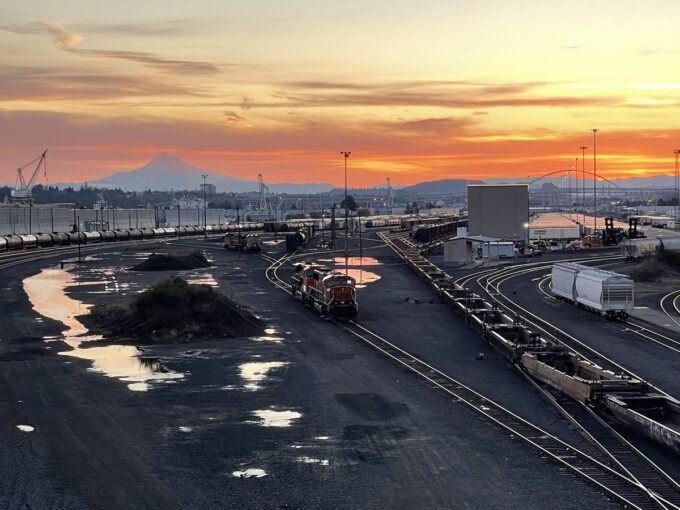How Empowering Public-Sector Workers Builds Stronger Communities

Photograph by Nathaniel St. Clair
Wayne Creasy turned the corner in his municipal work truck, saw emergency vehicles idling at the railroad crossing, and instinctively pulled over to help.
About 12 feet in the air, a railroad worker writhed in agony, pinned against his seat by a 39-foot-long, 1,500-pound slab of rail that fell from the claws of the crane he’d been operating.
Creasy—crew chief for the Bloomsburg, Pennsylvania, Public Works Department and president of United Steelworkers (USW) Local 1928—knew exactly what to do.
He summoned a town backhoe, moved a police car out of the way, and secured the backhoe’s chains to the piece of rail. Then he guided the backhoe operator, a fellow union member, as he hoisted the rail high enough for emergency workers to slide the man over the back of his seat to safety.
Decades of union empowerment prepared Creasy to act decisively and heroically on that summer day. Now, swift passage of federal legislation, the Public Service Freedom to Negotiate Act, would help build the same kind of leadership, skill, and teamwork in communities nationwide.
“We try to rise above and beyond,” Creasy, a town worker for nearly three decades, said of his 10-person crew, responsible for snow-clearing, street paving, flood control, tree maintenance, the town park, an airport, traffic signals, and many other community essentials. “If you know what to do, you do it.”
Some states unfairly deny public servants—not only road crews but sanitation, maintenance, and office workers, among others—the same right to union membership that counterparts in the private sector enjoy.
A right-wing governor in Wisconsin signed legislation in 2011, for example, that essentially eliminated bargaining rights for public workers there. In 2023, Florida’s anti-worker governor signed a law aimed at bankrupting and decimating public-sector unions, costing tens of thousands of workers their labor rights so far.
And Louisiana’s Republican-controlled legislature in 2024 introduced several bills intended to strip public workers of their unions.
The Public Service Freedom to Negotiate Act—backed by pro-worker members of Congress such as Senator Sherrod Brown of Ohio—evens the scales.
It would guarantee public workers the right to unionize, negotiate collectively, and fight together for better working conditions. The bill also would bar states from imposing burdensome paperwork requirements on unions, as Florida has, and establish a process for resolving bargaining stalemates.
“Protect yourself. Protect your rights. Protect your benefits,” said Creasy, urging public workers to organize for their own good and that of the taxpayers they serve.
Union membership affords Creasy a say on the job and also provides him opportunities to learn new skills, take on additional responsibilities, and problem-solve. Safety trainings showed him to think his way out of perilous situations, and the union instilled in him the importance of leaving no one behind.
All of that came together to save the crane operator.
“I just had to help the guy… I represent the union, the USW, and it was the USW to the rescue,” said Creasy.
“I’ve been with this department for 26 years. You see all sorts of situations. If you’re around heavy equipment, you know how to use it properly,” he explained.
“No doubt at all. No hesitation,” Creasy said of his hastily devised rescue plan. “We knew we had to lift the rail off of him, and the only piece of equipment going to do it was the backhoe.”
The Public Service Freedom to Negotiate Act would afford more public-sector workers the voice and resources needed not only to better protect the public but also to deliver services more efficiently and cost-effectively.
“The union offers training you don’t get anywhere else,” said Kevin Ziolkovski, president of USW Local 9411, who’s aided accident victims, a person in anaphylactic shock, and other stricken members of the public while working for Groton (Connecticut) Utilities.
At a recent labor conference, Ziolkovski trained on the use of Narcan, an emergency medication used to save overdose victims. Now, he plans to carry the medication with him on the job.
The USW’s broad reach enables Ziolkovski and other public workers across the country to compare notes and develop best practices for serving their communities. And unions enable public workers to speak out about service gaps or other problems.
“Because of the union, we are able to have some discussions we would be scared to have otherwise,” said Andrew Reed, president of USW Local 9187, which represents hundreds of workers in the Stark County, Ohio, Department of Jobs & Family Services.
Reed and other union members stepped up, for example, when they realized that long wait times put callers to the county’s Human Services Division at increased risk.
They spoke with county officials, juggled scheduling, and took other steps to drastically reduce the amount of time callers waited for help. In some cases, the changes shaved hours off of response times, said Reed, noting the agency provides food assistance, transportation, and other crucial services to residents in need.
With the union looking out for safety and workplace conditions, Reed noted, “workers are able to focus more on serving the public.”
In Bloomsburg, union solidarity not only enables Creasy’s crew members to work seamlessly together but fosters a greater shared commitment to the community they all call home.
“They depend on us and look up to us,” he said of the town’s residents and merchants. “We’re here for the long haul.”
This article was produced by the Independent Media Institute.
